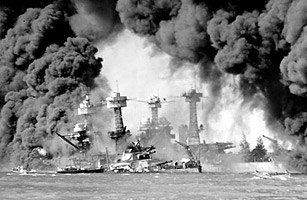
The U.S.S. California was hit in the first minutes of the attack.
Dec. 7, 1941
As the zeros flew overhead on that lazy Sunday morning, some of my neighbors in the hills on Oahu waved at the planes, not realizing that they were the enemy and that this would be the day that would go down in infamy. My family and I were having breakfast that morning, and as the eldest son in a family of Japanese immigrants, I was given a special treat: hotcakes. But the noise was inescapable. The bang bang bang became a resounding boom boom boom. I tried to assuage the family's fears, saying it must be only one of the weekly U.S. military exercises. Suddenly, an earth shaking varooom! rattled our flimsy home. I immediately jumped from my chair and started running through the rice fields and over the railroad tracks until I was standing on the shore with the water lapping at my slippers. Across lay Pearl Harbor.
I watched as one of the battleships, perhaps the Arizona, went up in flames, soon blackened by huge funnels of clouds shooting skyward. The West Virginia and the California started to explode in a chain reaction. I soon heard the rat-tat-tat of machine guns and squads of planes starting to dive-bomb the destroyers and cruisers nearest shore. I saw a large plane fly low over the water from the direction of Honolulu into battleship row and drop a torpedo toward the middle of the ships. The plane then turned toward Aiea, my hometown, hugging the surface of the water to avoid antiaircraft fire. As the plane flew a few hundred feet over my head, I saw the pilot with a canvas helmet and large goggles over his eyes looking down at me. As the plane headed north toward the mountains, I saw Japan's insignia, the Rising Sun. "How dare they come over and attack our land and country?" I raged to myself. Then a truckload of Marines came over and yelled at me to go home. On the way I saw a couple of Zeros on fire, plunging into the hills over my town.
The next day some of us sneaked over toward Pearl Harbor to see the damage. The long concrete pier along the shore was piled with stacks of bodies. The dead were later interred in a temporary cemetery nearby. National Guard soldiers soon took over and ordered every home to be blacked out at night. They shot at any light showing through the cracks. In our darkened, humid rooms, we huddled in dismay at the way our ancestral Japan had put a curse on all Japanese living in Hawaii. Other ethnic groups looked upon us as the enemy, not to be trusted. Our village elders soon got together to burn or destroy anything to do with Japan: photos of the Emperor, flags, swords and even shortwave radios that could be turned into transmitters. Still, the police on the sugar plantation where we lived led the FBI into Japanese homes. Many people were rounded up: language teachers and martial-arts instructors as well as labor leaders and businessmen. My future father-in-law was arrested at rifle point and incarcerated in one of 10 relocation camps. Second-generation Japanese-American soldiers in the 298th and 299th Regiments were asked to leave the service, their rifles taken away.
Eventually, Japanese-American ROTC students formed the Victory Varsity Volunteers and joined the newly formed 442nd Regimental Combat Team. I would join too. I remember my parents saying "Don't bring shame to the family," adding that they would rather never see me again than have me avoid the dangers of serving in the Army. Using the old code of Bushido, the way of the samurai, they exhorted me to fight to the death for America.
Oba, author of Men of Company F, 442nd Regimental Combat Team, served in Italy and France